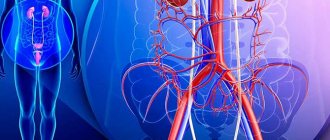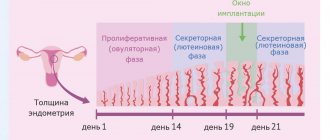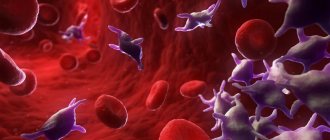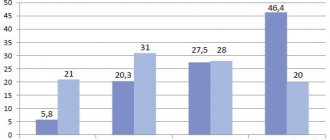Published: 06/28/2021 13:30:00 Updated: 06/28/2021
Amenorrhea is a condition in which women of childbearing age do not have menstrual periods for three months with a previously regular cycle and six months or more with an irregular cycle. During pregnancy and breastfeeding, it is considered a normal manifestation of physiological changes in the reproductive system. In other cases, the violation indicates a pathological process of the reproductive system or hormonal imbalance. These deviations are a serious pathology and are closely related to the development of infertility and many other diseases.
Among women aged 16–45 years, the prevalence of pathology varies from 5 to 13%. Moreover, in the vast majority of cases, the condition develops in previously menstruating patients, and only in 25% does primary amenorrhea occur - delayed menarche (first menstruation) in girls.
Causes and forms of the disease
Pregnancy is the most common cause of amenorrhea.
After childbirth, bloody discharge – lochia – is observed from the genital tract for some time. In the future, when breastfeeding, menstruation is absent for several months - this is lactational amenorrhea. Such changes are associated with high secretion of prolactin in the body and are not a deviation. Secondary amenorrhea occurs with diseases of the reproductive organs, oncological processes, and neuroendocrine disorders. The latter can be caused not only by pathological changes in the hypothalamic-pituitary region, but also by a significant decrease in body weight or stress. Most often, the occurrence of central forms of amenorrhea is preceded by mental trauma, neuroinfections, intoxication, complicated pregnancy and childbirth, endocrine diseases, taking medications (reserpine, opioids, monoamine oxidase inhibitors, haloperidol, metoclopramide), and tumor lesions of the brain. In this case, the production of hypothalamic gonadotropin-releasing hormone is disrupted, which leads to a change in the secretion of follicle-stimulating, luteinizing, adrenocorticotropic, somatotropic, thyroid-stimulating hormones and prolactin. Estrogen production also decreases, egg maturation does not occur in the ovaries, and the uterine epithelium is not renewed. Similar processes are also observed in patients with schizophrenia and manic-depressive psychosis.
The ovarian form of amenorrhea occurs in polycystic ovary syndrome, premature ovarian failure (ovarian wasting syndrome or early menopause), resistant ovarian syndrome, androgen-producing tumors of the organ. At the same time, egg maturation and the menstrual cycle are also disrupted.
The cause of the adrenal form of the disease can be a number of diseases in which there is excessive production of male sex hormones (adrenogenital syndrome) or cortisol (Cushing's disease and syndrome). Excessive release of androgens inhibits the production of gonadotropins in the brain.
Amenorrhea of thyroid origin is often caused by diseases of the thyroid gland, primary or secondary hypothyroidism. In this case, the pituitary gland (a special gland located in the brain) produces more TSH, which leads to the suppression of neighboring cells responsible for the production of LH, FSH, and subsequent inhibition of ovarian function. In case of hyperthyroidism, the function of the organs of the reproductive system is also impaired.
The uterine form of the pathology is associated with functional or anatomical disorders in the uterus. The cause may be the occurrence of adhesions due to traumatic damage to the endometrium during abortion, genital tuberculosis, after surgical interventions on the organ, diagnostic curettage, endometritis. There is no full monthly renewal of the mucous membrane; there are no menstruation. If an infection occurs only in the area of the cervical canal while the endometrium is intact, false amenorrhea develops - blood accumulates in the uterine cavity with no outlet.
Primary amenorrhea can occur with or without delayed sexual development. In the first case, the disorders are associated with ovarian malformations, such as gonadal dysgenesis, testicular feminization syndrome, or congenital or acquired dysfunction of the hypothalamic-pituitary system. Pathology can be caused by malnutrition, chronic infection, intoxication, kidney disease, liver disease, and anemia. It occurs with gigantism, tumors and congenital malformations of the corresponding area of the brain. Delayed menarche and normal development of secondary sexual characteristics are observed in the absence of natural openings for the exit of menstrual blood - gynathresia (infestation) of the hymen or vagina, aplasia (underdevelopment) of the uterus.
Iatrogenic amenorrhea deserves special attention - a consequence of surgical removal of the uterus and/or appendages, the use of certain medications, radiation or chemotherapy.
Consequences
Amenorrhea does not threaten a woman’s life, but can cause infertility and pathological changes in the pelvic organs, such as:
- Reduction and atrophy of the uterus
- Destruction of the endometrium with the formation of adhesions
- Complete blockage of the uterus
- Osteoporosis (increased bone fragility)
Unfortunately, if a woman does not consult a gynecologist on time, the consequences of amenorrhea can be irreversible. The listed pathologies are extremely difficult to treat, and in some cases a woman is forever deprived of the opportunity to become a mother.
Don't be afraid to see a doctor. If menstruation is absent for more than 2 months in a row, you need to make an appointment with a gynecologist and find out the reasons for this phenomenon. Only a specialist can conduct a full examination and prescribe treatment.
Gynecologists from the network of Moscow MCs “Zdorovye” are always ready to help patients with any problems related to sexual and reproductive health. We guarantee complete confidentiality, professional approach and tact of the medical staff. Make an appointment with a gynecologist on the website medcentr.biz
Symptoms of amenorrhea
The main manifestation of the disorder in the case of secondary amenorrhea is the absence of menstruation for more than 3 months with a previously regular cycle or for six months with an irregular one. With primary amenorrhea, menarche (first menstruation) does not occur until age 16. The remaining symptoms depend on the form of the pathology, however, with any of them, the duration of reproductive dysfunction for more than a year leads to infertility.
Central form
Damage to the hypothalamic-pituitary region of the brain is accompanied by the characteristic appearance of patients: overweight, a rounded moon-shaped face, a fatty apron, purplish-red stripes on the skin of the abdomen and thighs. However, excessive thinness with weakly expressed secondary sexual characteristics is also possible. With tumors of the pituitary gland, progressive headaches, symptoms associated with excessive secretion of tropic hormones - acromegaly (unexpected growth in adulthood of the feet, hands, nose), increased irritability, and bulging eyes - can be observed. Hyperprolactinemia is manifested by discharge from the mammary glands, their soreness and engorgement, and decreased libido.
Ovarian form
Congenital ovarian dysfunction is accompanied by an almost complete absence of secondary sexual characteristics - undeveloped mammary glands, scant hair growth in the pubic and armpit areas, and a male physique.
Shereshevsky-Turner syndrome (a congenital genetic pathology) is characterized by the patient's short stature, wing-shaped folds of skin on the neck, high “Gothic palate”, barrel-shaped chest, valgus (X-shaped) joint deformity, and malformations of the cardiovascular system. With a deficiency of enzyme systems, increased blood pressure and pain in the lower abdomen are possible. Exhausted ovarian syndrome is accompanied by decreased sexual desire, vegetative-vascular and psycho-emotional disorders characteristic of menopause. With polycystic degeneration of the organ, the appearance of hirsutism is possible - excessive hair growth on the face, body, inner thighs, as well as visceral obesity, diabetes and cardiovascular disorders.
Uterine form
Primary uterine amenorrhea may be accompanied by symptoms of congenital defects in the urinary system. With a false form and synechiae in the uterus, there is cyclical pain in the lower abdomen.
Amenorrhea with endocrine disorders
With hypothyroidism (decreased thyroid function), dry skin, swelling, hair loss, and fatigue are noted. Pathological changes in the adrenal glands are accompanied by increased hair growth on the body and face, baldness, skin rashes, and muscularization. Patients with Cushing's syndrome or disease (a condition with excessive cortisol production) suffer from excess weight, their face is puffy, round in shape, there are purplish-red stretch marks on the skin, and their limbs are disproportionately thin.
Medicines
Photo: gripptips.ru
Treatment with drugs
Primary amenorrhea is most often treated with hormonal pills and a special diet that promotes weight gain through muscle mass. Vitamins for amenorrhea in the primary form are a mandatory form of treatment. In addition to special vitamin complexes for amenorrhea (vitamin E, vitamin B1 in solution, folic acid), it is recommended to introduce into the diet foods containing vitamin E, estrogen, folic acid, vitamins that provide significant assistance for amenorrhea.
Estrogen is found in:
- legumes;
- bran;
- apricots;
- coffee.
The following foods contain folic acid:
- spinach;
- salad;
- dark greens;
- celery;
- berries;
- peas;
- carrot;
- pumpkin;
- corn.
Vitamin E for amenorrhea is replenished by:
- sea fish;
- greenery;
- berries;
- porridge;
- nuts.
Taking vitamins during amenorrhea strengthens the nervous system and creates the prerequisites for restoring reproductive function naturally. Treatment of amenorrhea with vitamin preparations reduces nervous tension and improves tone. If this is the primary form, then pills for amenorrhea may not be needed, the function of the ovaries will recover on its own. Drugs for amenorrhea for girls are prescribed only in severe cases.
Vitamins, hormones, drugs (Folliculin, Cyclovita) and physical exercise eliminate health problems in teenage girls. Vitamin complex Cyclovita is a drug that replenishes the lack of minerals and vitamins and restores the tone of a weakened body.
Treatment with hormonal drugs is prescribed when a special diet and vitamin complexes do not help.
Primary amenorrhea caused by infectious diseases or intrauterine infections is treated with special medications.
In case of secondary type amenorrhea, in addition to hormones, they are treated with special diets, physiotherapy and vitamins necessary for patients of any age.
For secondary amenorrhea, specialists may prescribe the hormonal drug Duphaston. This is a progestogenic hormonal drug that includes dihydrogesterone. Duphaston is used for primary and secondary amenorrhea as hormone replacement therapy. Treatment of amenorrhea with Duphaston allows for effective therapy for patients of reproductive age.
Treatment of amenorrhea with Duphaston can be replaced with its analogue Utrozhestan. The drug is natural progesterone. Utrozhestan compensates for the deficiency of endogenous progesterone and replaces several drugs prescribed for the treatment of amenorrhea. Utrozhestan has no side effects and is quickly eliminated from the body.
Also, patients with amenorrhea are prescribed hormonal drugs to restore ovarian function in tablets.
Treatment of amenorrhea with replacement therapy drugs:
- Progestin drugs: Utrozhestan, Duphaston, Pregnin, Norkolut. For amenorrhea, these drugs are widely used to treat primary and secondary forms.
- Estrogens: Femoston, Femoston 210, Rigevidon.
- GnRH hormones: Cyclomate. Used to treat amenorrhea caused by polycystic ovary syndrome.
- Non-steroidal synthetic drugs: Clomiphene. These tablets stimulate ovarian function.
Cyclodinone (an analogue of Utrozhestan) is prescribed for amenorrhea to restore the cycle and prevent early menopause. Cyclodinone contains twig berry extract.
For amenorrhea, Femoston, like Cyclodinone, is used in case of insufficient hormone production.
Femoston helps restore the cycle against the background of stressful situations and sudden weight loss. It is prescribed to women after 40 years of age to delay early menopause, which is based on a deficiency of female sex hormones associated with women reaching a certain age. Femaston helps prevent hot flashes, emotional breakdowns, bone depletion, headaches, and dry mucous membranes.
Femoston lowers blood cholesterol levels, lowers LDL and increases HDL, prevents the risk of carcinogenesis and endometrial diseases.
Diagnosis of amenorrhea
A gynecologist diagnoses and treats reproductive dysfunction.
During a conversation with the patient, the doctor clarifies the duration and regularity of the cycle, how long menstruation has been absent, what complaints and concomitant diseases are present, the number of births, miscarriages and abortions, the method of contraception used, the nature of nutrition, the presence of physical and mental overload, the time of onset of menopause in the mother and grandmothers, medications taken - all this helps to identify the characteristics of the body of a particular woman. The woman's height and weight must be measured and her body mass index calculated. During the examination, the soreness of the appendages is determined, the condition of the external genitalia, vagina, mammary glands, body hair is assessed, and the skin is examined. In women who have previously menstruated, pregnancy is ruled out first. To do this, a blood test for human chorionic gonadotropin can be performed, and an ultrasound of the uterus and appendages can be performed. If physiological causes of pathology are excluded, further laboratory and instrumental diagnosis of amenorrhea involves the following studies:
- daily measurement of rectal temperature with subsequent drawing up of a schedule;
- determination of the level of hormones in blood serum: prolactin, progesterone, estradiol, sex chromatin, follicle-stimulating and luteinizing hormones, androgens;
- Ultrasound of the pelvic organs to exclude polycystic ovary syndrome and determine the condition of the endometrium;
- cytological analysis of a smear from the posterior vaginal fornix to determine the estrogen saturation of the body.
According to indications, MRI and CT of the brain, ultrasound of the urinary system, hysteroscopy, separate diagnostic curettage of the uterine cavity, blood tests for sex hormone-binding globulin, antibodies to the own cells of the ovaries, thyroid or adrenal hormones are performed. If primary amenorrhea is suspected, the examination also includes karyotyping (genetic testing).
Bibliography
- Vikhlyaeva E.M. Hyperprolactinemia and reproductive system disorders. Guide to Endocrine Gynecology
- Gurkin Yu.A. Adolescent gynecology / guide for doctors
- Berek J., Adasi I., Hillard P. Gynecology according to Emil Novak
- Manusharova R.A., Cherkezova E.I. Gynecological endocrinology / guide for doctors
- Bogdanova E.A. Gynecology of children and adolescents
- Smetnik V.P. Non-operative gynecology / Smetnik V.P., Tumilovich L.G. – 3rd edition. – M.: MIA, 2003.
- Heffner L. The human reproductive system in normal and pathological conditions: A visual textbook // Trans. from English – 2003. – 128 p.
- Gordner D., Shobek D. Basic and clinical endocrinology. – M.: Publishing house. "Binom", 2010.
Treatment
Treatment of amenorrhea comes down to correctly identifying and eliminating the cause that led to a long absence of menstruation.
Tactics depend on the patient’s age, form of amenorrhea, and the presence or absence of other diseases. General recommendations for amenorrhea:
- Eliminate psycho-emotional overload. It is necessary to avoid stressful situations or use psychological auto-training, yoga and taking sedatives to minimize their impact.
- Adjust your diet. If amenorrhea is caused by a strict diet or anorexia, it is necessary to balance the diet to quickly normalize weight. With some hormonal disorders, obesity is present, which also requires a revision of the menu.
- To refuse from bad habits.
- Avoid high physical activity. If you have menstrual irregularities, it is not recommended to engage in strenuous sports.
With secondary amenorrhea, the first step is to normalize body weight and metabolism. According to indications, such patients are prescribed hormonal correction and symptomatic therapy. Depending on the nature of the disorders, the following drugs are used:
- natural estrogens;
- progestogens;
- dopamine receptor agonists;
- analogues of gonadoliberin or gonadotropic hormones;
- sedatives and painkillers.
For anatomical disorders, surgical treatment is possible - removal of tumors or organs with a high risk of malignant degeneration, plastic reconstructive surgery.
If the cause of reproductive dysfunction is diseases of the endocrine glands, then the patient is managed together with an endocrinologist.
Possible complications
Primary amenorrhea, the presence of which is ignored for a long time, can lead to:
- infertility (impaired reproductive function is observed in most cases, is difficult to correct or cannot be corrected at all, often the only solution is IVF or surrogacy);
- osteoporosis – a condition in which destructive processes in bone tissue prevail over restoration processes and, as a result, bones lose their strength;
- atherosclerosis – deposition of lipid plaques on the walls of blood vessels, which lead to narrowing of the lumen of the vessel and, as a result, disruption of blood flow;
- obesity – hormonal imbalance in the body often leads to excess weight gain, in which diets are ineffective.
Folk remedies
Photo: itd3.mycdn.me
Treating amenorrhea with folk remedies is a common practice, but this approach is safe only in consultation with a doctor. This is necessary due to possible individual intolerance to medications.
Herbs for primary amenorrhea
It is impossible to induce menstruation with such a deviation using homeopathy, but improving hormonal levels and general well-being is a solvable task. Applicable:
- infusion of oregano. Has a calming effect;
- sage extract is a phytohormone with properties similar to female sex hormones.
Folk remedies in the case of primary amenorrhea usually provide only maintenance therapy; this form of the disease requires a more radical approach.








